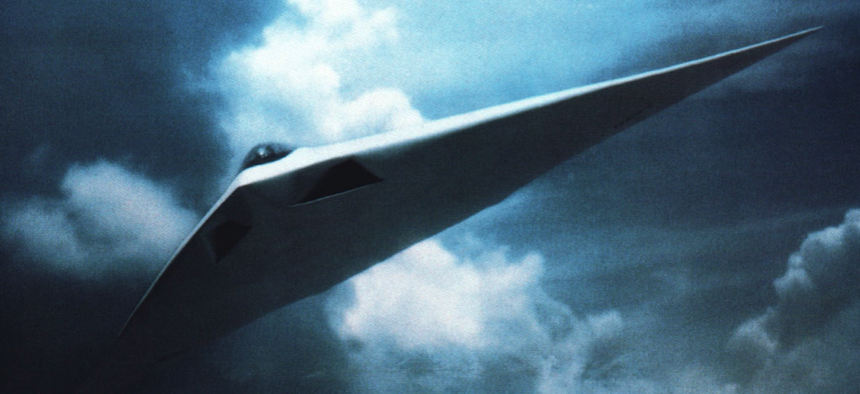
An artist's concept of the McDonnell Douglas A-12 Avenger II aircraft. U.S. Navy
Lessons from a Failed Stealth Jet Can Guide Naval Aviation’s Future
The Navy’s next jet must avoid the errors that doomed the Avenger II.
Attendees of the recent Sea Air Space conference in Maryland could have learned any number of things about current and future naval aviation. But, as the Hudson Institute’s Bryan Clark and Timothy Walton observed, those things did not include how naval aviators are going to extend their combat reach far enough to evade defenses that can hit aircraft carriers a thousand miles off the Chinese coast.
Clark and Watson acknowledge the Navy’s plan to use the MQ-25 unmanned tanker aircraft extends the range of existing aircraft. But that tactic comes at an operational cost. Adding unmanned tankers to a carrier air wing reduces the space for strike aircraft. To mitigate this, they recommend more integration between at-sea naval aviation and shore bases. This certainly must be part of the Navy’s future, but it isn’t enough.
As the Navy works on a replacement for its 30-year-old F/A-18, it would do well to recall some painful lessons of the past. What comes to mind is Avenger II, the wedge-shaped attack aircraft proposed in 1983 and canceled a decade later as costs soared and the Cold War-related need dwindled. Two lessons jump out: changing requirements can be costly, and the strategic context matters.
Fortunately, it seems some of the lessons are being heeded. For one, the Navy is working with the Air Force in developing a new aircraft called the Next Generation Air Dominance, or NGAD. While details of the platform are scant, Vice Adm. Dean Peters described a new focus on designing an airframe around the capabilities needed. The opposite approach—trying to pack technology into an existing airframe—contributed to the out-of-control costs of Avenger II, as modification after modification became necessary.
Hopefully, longer combat range is included in those desired NGAD capabilities. If not, it will further tax the strike capacity of aircraft carriers for added tanker capacity.
NGAD’s success will also depend on the weapons and sensors it carries—and once again, range will be key. Driving the requirement for longer-range weapons are threats such as China’s air-to-air PL-15 missile; its 186-mile range is double the longest air-to-air missile in the U.S. arsenal, the AIM-120D. In aerial battles, as in boxing, the fighter with the longer reach can dominate the fight. There’s good news on this front: The Air Force tested a developmental missile in April that might close this range disadvantage.
Like the Avenger II cancellation proves, strategic context must be considered when planning for the replacement of existing aircraft. The first step is to define the role of NGAD within in a wider strategy. Today’s F/A-18-heavy carrier air wing is a product of the 1990s’ “From the Sea” naval strategy, which emphasized uncontested strike. This eventually led to the retirement of specialized aircraft like the A-6 strike, S-3 anti-submarine, and F-14 fighter platforms.
Today, the Navy is trying to free up money for NGAD by pushing back on efforts to continue building F/A-18s. But that kind of thinking is too narrow. The service has yet to establish a clear vision for how it will maintain its capacity for lethality until NGAD is deployed (likely no earlier than the mid-2030s) and how NGAD will complement today’s naval F-35 variants. Until that happens, stopping Super Hornet procurement is premature.
A decision to abandon F/A-18 production at this stage misses two key points: The Navy will be operating and maintaining a fleet of F/A-18s for another decade at least; and many regional partners key in great power competition such as Malaysia and Finland employ the F/A-18 and likely will continue to do so for a long time.
Keeping F/A-18 production going, albeit at a lower rate, to expand key strategic partners’ capabilities through favorable Foreign Military Financing makes good strategic sense. It helps in the competition with China and Russia and also mitigates costs to maintain the Navy’s -E and -F variants by keeping parts production apace. As these aircraft age, such costs otherwise will quickly rise until phased out over the next decade.
The Navy needs to reimagine the composition and capability of the carrier air wing—something that can then inform the design of new lite carriers or modifications of existing aircraft carriers. But this reimaging should also consider how the carrier air wing fits into a regional land-based posture and enhances alliances too.
Brent D. Sadler is the senior fellow for naval warfare and advanced technology at The Heritage Foundation’s Center for National Defense.
NEXT STORY: Taiwan Wants Paladins. Congress Should Say No




